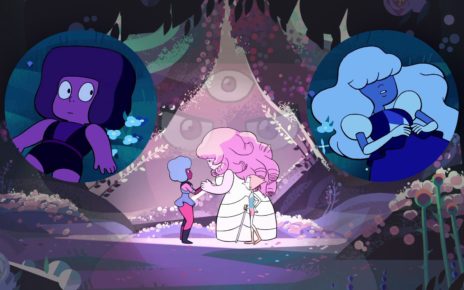April 30 marks the U.S. premiere of Ingress: The Animation, an action anime adapted from the augmented reality mobile game of the same name, on Netflix. The story follows a special investigator whose ability to see the history of any object he touches gets him wrapped up in a conspiracy involving a substance that can influence human thoughts and the two factions waging a war to harness it. Needless to say, it’s packed with action and suspense. Except…the soundtrack, composed by Jacob Yoffee, deliberately works to eschew action music tropes. The Dot and Line talk to Yoffee about how he came to Ingress, working on a score for a video game adaptation, and more.
How did you get into the business of scoring for television and film? What other work have you done, and did it affect your work on this series at all?
Ever since I was eight years old, I wanted to write music for film and television. It may sound funny, but I remember watching Gremlins as a kid, and the music suddenly hit me. From that moment forward, film music was my goal, while also exploring my love of music in general. I studied composition and performance in college, the mechanics and theory of music, and as many styles as I could, which has been fundamental in this business.
Before starting on Ingress, I’d scored more than25 feature length films and many episodic projects, like Disney Channel’s Andi Mack series, MTV’s Finding Carter, and Showtime’s Time of Death series. Not only was the experience of writing in many different styles helpful, but also learning how to produce a large amount of music VERY quickly — all synced to picture. It’s always a delicate balancing act of creativity, time, and logistics.
What made this project unique is the fact that I was replacing a video game score specifically to deliver a fresh, new sound. It wasn’t enough to merely support the action on screen. They wanted the building blocks of every piece of music to start with new and unfamiliar sounds.
Were you familiar with the games Ingress and Ingress Prime before being commissioned for this project? Did the scores from those games play any factor in developing music for this series?
The first time I heard about the games was the day I started work on the series. A producer came to my studio and showed me footage from the show, where they had temped in some of my music from another project. He explained the background of the show, the game, and the incredible complex narrative that holds it all together. After that, I played the game a bit but, honestly, there wasn’t time to do anything but write the music at that point! Luckily, my job was to do something that was unexpected and different, so perhaps my ignorance of the game’s soundtrack was beneficial.
What pieces and artists were some of your biggest influences for this score? In general?
There’s a growing interest in using found sounds, Foley, or out-of-the-box sound recordings in pop music. A genre has emerged called IDM, which stands for “intelligent drum music,” rather than the more familiar EDM. Musically, that was the world: odd sounds that were stretched to create pads, or alarming shrieks and squeals, processed and manipulated drums — all mixed with analog synths and digital instruments. There are a bevy of artists working in this realm that I really admire, among them Odesza, Trent Reznor, Atticus Ross, Junkie XL, and the late Jóhann Jóhannsson.
You were instructed to write a score that doesn’t have “action music.” What techniques did you employ to include tension in your score without making it feel like an action soundtrack?
This took some experimenting and was one of the most fun parts of the process. It actually all started with some music I’d written in 2013. The producer and sound designer on the film had temped it into a few sequences, intentionally placing it where you would normally use big action sequences. It gave the show a completely different feeling and actually made you pay attention to the incredible animation more. After that piece was placed as a kind of proof of concept, I was able to get going pretty quickly.
And since the film was already locked, time-wise, we could play off the movement on screen — knowing that the exact frame when somebody was shot, or falls or throws a punch, wouldn’t change. With that as an anchor, we could leave musical space and build wide beats and breath in the music that sort of danced with the picture.
You’ve said about this soundtrack that the music is scored to picture “as if it’s live-action film.” Can you explain what that means, and what the differences are between scoring to animation and scoring to live-action?
There are no hard andfast rules for scoring, but there’s always a feeling of the general standard practice. In animation, the visuals are creating everything from nothing, so it’s all fakery that needs help to bring it to life. No matter how great the visuals are, sound helps bring it across the finish line. It’s great fun for the audio team because we get to really flex.
With live action, you’re seeing the real world and they’re capturing sound on set or on location. So the audience doesn’t need to be told that they’re looking at a person or the ocean or a city. With live action scoring, especially in modern films, music has become more and more subtle. Composers are tasked with “saying something without saying something.” The idea is usually that you don’t want to tell audience what to feel, but rather let them decide their own reaction. Exceptions occur, of course, but this is just a general feeling of the standard practice.
Regarding Ingress, we wanted to elevate the feeling of the show and have faith that the visuals would deliver the “temporary suspension of disbelief” needed. The animation is incredible and has an amazing style to it. We decided to let that stand on its own and focus on building the music as a style, and not focus on filling up everything to breathe life into it. That meant that we weren’t writing to add color, fun, or fantastical whimsy, but rather primal grit, intensity, and intrigue.
Thanks for reading The Dot and Line, where we talk about animation of all kinds. Don’t forget to follow us on Twitter and sign up for our newsletter.





